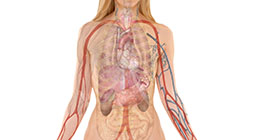
If you have already read my first book, The Immune System Cure, you probably have a good understanding of the immune system. This article provides more information on the developments and new discoveries in how the immune system functions and exciting new research on stress and immunity, autoimmune disease, pain and the immune system.
An Immune System Overview
Life is all about balance. Those who have discovered the joys of physical and emotional health have perfected the art of juggling work and play, exercise and relaxation, good food and junk food. On a smaller scale, even certain body functions are programmed for balance—our hormones need to be in the right ratios for optimal health, the acidity or alkalinity of the body is carefully controlled, and microscopic cells of the immune system must be in harmony or disease results.
The key to optimal health lies with our immune system. Returning balance and strength to the immune system in the face of daunting diseases like AIDS and cancer may seem very challenging. Allergies, autoimmune disease, viral infections (including herpes and human papilloma virus, the virus that causes warts and that is implicated in cervical cancer), HIV, cancer, and even heart disease are linked to a dysfunctional or imbalanced immune system.
Media reports would have us believe that boosting the immune system is the key to correcting all deficiencies, but scientists are learning that many common diseases are caused by overactive or misdirected immunity. Autoimmune disease, allergies, and inflammatory conditions like fibromyalgia and osteoarthritis are a few of the diseases where balancing immune function is more appropriate.
Immune modulation is the medical term for balancing your immune system. Intricate processes must occur in our immune system to ensure optimal function.
Little evidence is required to demonstrate how crucial the immune system is to our survival. Researchers noted that once people had recovered from some types of illness (like measles or mumps), they usually would not become infected again. It was discovered that if people survived, they developed life long protection against that specific illness.
Childhood is looked upon as immunity’s training ground, the time when this important defense system learns to recognize and fight against harmful organisms. If an infant is born with a defective immune system, the baby’s only chance of survival is to be protected in a completely sterile environment from germs of all types.
Immunity to diseases like chicken pox, measles, smallpox, and other infectious organisms is based on the production of antibodies, Y-shaped glycoproteins produced by white blood cells. This protein is programmed to kill a specific intruder or antigen (foreign matter that provokes a response from the immune system).
Antigens are attached to the surface of a virus or bacteria and form a unique structure that can be recognized only by an antibody specifically designed to identify that structure. When a different antigen is presented, its specific antibody must be produced each and every time. As we gain more and more antibodies, we develop resistance. Resistance to a specific antigen is called immunity. However, the immune system provides several methods of defense to protect us from foreign invaders.
When a foreign organ is transplanted, patients must take immunosuppressants to prevent organ rejection because the immune system is so vigilant about anything foreign in the body that it will destroy the newly transplanted organ. Immunosuppressant drugs prevent rejection, but make a person highly susceptible to infections and more serious conditions such as cancer and osteoporosis. Withdrawing the immunosuppressants can reverse the conditions, but only by sacrificing the transplanted organ.
The appearance of acquired immune deficiency syndrome (AIDS) has sparked a flurry of interest in immunology not seen since the smallpox epidemics. AIDS, a devastating disease brought about by the human immunodeficiency virus (HIV), suppresses the immune system and leaves a person so vulnerable to opportunistic infections that even minor infections can become fatal.
Immunity Starts at Birth
Healthy babies inherently benefit from the natural immunity they get from their mothers as their own immune systems mature. This innate immunity or resistance to disease begins with a response against a broad range of foreign infiltrators. The response is so subtle that you are not even aware that it is going on.
First Line of Defense
The perimeter of defense begins with the physical barrier of the skin and mucous membranes. The skin keeps bacteria and foreign particles out, excretes toxins and waste from within the body by sweating, and regulates body temperature. Mucous membranes of exposed body cavities—such as nasal passages, the eyes, the vagina, and the mouth—are vigilant in neutralizing potential invaders before they can enter. Saliva, tears, and vaginal secretions are the weapons that enable them to dilute and wash away microbes.
Think about how many times a day you touch your finger to the side of your nose, eyes, or mouth. Each time we do this we provide invaders direct entry into the inner body. The immune system protects us by making sure that all of our body fluids are rich in immune factors that destroy bacteria, viruses, parasites, and more, but what if we are dehydrated?
Water is essential. It ensures that we have fluid-rich areas that are full of potent immune factors. If we are dehydrated, those fluids and their immune factors around the eyes, nose, and mouth shrink and invaders have an open door to our bodies. Water is the least expensive and most effective virus fighter. Ensure that you drink eight glasses a day, especially in the winter when you are in your centrally heated home and the viruses are just waiting for an opportunity to gain hold.
If an invader gets past our physical barriers, then our immune system is waiting with a powerful arsenal of cells and immune factors. Have you ever gotten a piece of a thorn from a raspberry bush or rose stuck in your finger? Within a few hours the place where the thorn damaged the skin will become red and inflamed or swollen. This means that your innate immunity has launched an attack and is repairing the broken skin. In the tissues of your skin, macrophages are defending you against infection. A full-blown inflammatory response is now occurring in your finger.
Your Immunity Army
Your immune system is made up of organs including the thymus, spleen, bone marrow, lymph glands and microscopic cells that communicate with one another through chemical messengers called cytokines and they regulate many other systems of the body. The main cells include natural killer (NK) cells, T-Helper-2 cells, cytotoxic T-cells, B cells, and macrophages.
Macrophages
Macrophages are the cells that eat and digest foreign matter (macrophage literally means “big eater”). They are like Pac-Man cells that go throughout the body, eating and digesting invaders and waste products and taking pieces of those invaders and presenting them to other immune cells so they can be recognized for destruction.
When an infection occurs, the macrophages patrolling the area trap, break up, and destroy the foreigner, a process called phagocytosis. As well, macrophages release certain immune factors or chemical messengers to alert the rest of the immune system.
Unlike some immune cells that are very limited as to which microbes they can destroy, macrophages are not very picky, so they will attack a wide variety of viruses, bacteria, and old and dead cells. Although not all invaders are destroyed, this method is very effective. Some microbes, including staphylococci and tubercle bacillus, can actually kill macrophages or remain dormant for months or even years as they wait for the immune system to weaken and become vulnerable to attack. A healthy immune system, however, can stop these trouble makers in their tracks or leave them waiting dormant for their “big break” as long as we live.
Fever
Fever is another method of preventing bacteria and viruses from taking hold. Elevating the body’s temperature, even by two degrees, can hinder an invader’s progress or kill it. The phagocytes release pyrogens (a fever producing substance released by phagocytes) to induce fever. If the fever goes too high (just a few degrees or more), it can be deadly to the host. Because the window of opportunity to destroy viruses is so narrow and the ill-fated consequences lethal (death of the individual or the brain cells), immunologists are beginning to hypothesize that fever is an outmoded method of immune system defense, and that if humans survive another several thousand years, we may evolve in such a way that fever may no longer be used to kill invaders.
Inflammation
Inflammation is also a way for the body to defend itself and can be activated within seconds of an injury or invasion. The pain, redness, swelling, and heat that we feel destroys microbes, toxins, and other foreign material at the site of penetration. The blood vessels are constricted to repair damages and prevent the infection from spreading further. Following the activation of several different immune cells—including mast cells, macrophages, and T-cells—the lipids in the cell membranes are converted into inflammatory mediators that have potent effects.
There are three inflammation promoters: prostaglandin D2 (PGD2, derived from arachidonic acid), leukotrienes (also from arachidonic acid), and platelet-activating factor (PAF, produced by mast cells). Certain nutrients, such as essential fatty acids, control these inflammation promoters. For example, PAF released as a result of the immune response, has a profound effect on smooth muscle tissue in the lung, causing bronchial constriction, tightness in the chest, and wheezing, all of which are symptoms of asthma.
Remember that inflammation is necessary to heal tissues or eject an invader and becomes a problem only when it is chronic or long term. We don’t want to totally eliminate inflammation in the body or we will stop the immune system from healing damaged tissues.
The problem with some of the strong anti-inflammatory medications is that they can slow the inflammatory response to the point where the immune system cannot do proper healing or eliminate invaders.
Complement
Complement, another agent of the immune system, is a combination of 20 proteins (enzymes) that circulate in the blood acting as catalysts in antibody reactions. When an invader appears, complement releases a protein (enzyme), then another enzyme, and another in a cascade until all 20 proteins have been set in motion.
Each one of the 20 steps in the complement reaction has a particular function that happens at an appropriate phase in the process of killing invaders. The end result is that complement proteins call in a cavalry of phagocytes to the site of the inflammation and turn them into voracious eaters of the invaders.
Powerful Cancer-Fighting Cells
Natural killer cells (NK cells) are like assassins or professional hit men in that they have a little more finesse in the way they operate compared to macrophages. They destroy their attacker by penetrating its surface and releasing toxic enzymes into it. Like phagocytes, NK cells assume their own command and do not need to be told to kill invaders. However unlike antibodies, they do not have memory, so each confrontation is a new battle.
NK cells target parasites, viruses, bacteria, and fungi, but they have an extra assignment. They seek out and destroy cancerous cells on contact before they attach and develop into a tumor—in effect, they are the first strike against cancer. NK cells also attack cells infected by pathogens other than viruses. Studies evaluating cancer patients’ immune status have shown that their numbers of NK cells are drastically reduced; the lower the number of NK cells, the more severe the cancer.
An interesting characteristic of NK cells is that they release interferons, the chemical messengers or immune factors that prevent virus replication. Interferons incite aggression in NK cells and call more NK cells to join the fight, thus improving their overall killing ability.
Our immune system is incredibly intricate and sensitive to subtle changes, but it runs like a well-tuned orchestra and keeps us healthy as long as we provide it with all the tools it needs: good nutrition, supplements, relaxation, and exercise. If we have been neglectful by not getting enough nutrients or are under an excessive amount of stress, we put a dent in the armor, so when a particularly strong or determined microbe beats our immune system, we get sick.
The Thymus, a Superhero
The thymus is a flat, soft, pinkish-gray gland that sits behind the breast-bone. At birth, it is bigger than the heart. Physicians in the 1950s mistakenly believed that a large thymus was a defect in infants and used radiation to shrink it. Thankfully, this practice was stopped when they realized that a strong healthy immune system required a healthy-sized thymus gland.
The gland continues to grow until puberty when it reaches approximately 1.2 oz (34 g). As we age, it gradually shrinks, resulting in a corresponding decline in immunity. Doctors have told patients that this is a normal aging process, yet vitamins A, C, and E and the minerals zinc and selenium can enlarge even the most immune-compromised and shrunken thymus gland.
Conventional wisdom of the past dictated that a loss of immunity was to be expected through the course of aging. Aging decreases production of the hormone thymulin, which in turn decreases the production of T-cells and prevents the immune system from maturing.
We now know that the thymus is not doomed to shrink. Tarzan really knew what he was doing when he was pounding his chest. Find the curved bone in the center of your chest and gently pound it about a dozen times. Do this when you think about it throughout the day. This is a form of acupressure that stimulates the thymus gland to maintain size and the secretion of thyroid hormones.
Not Just Lymphing Along
The lymphatic system is made up of lymph fluid, lymphatic vessels, bone marrow, lymph nodes, the spleen, and the tonsils. It is involved in the elimination of toxic waste from tissues and is a crucial component of the immune system. Muscles, not the heart, pump fluid through this system. A sluggish lymphatic system is usually attributed to a lack of exercise.
If the battle against an infection is underway, the lymph glands become swollen and tender as they try to clear and clean the system. One of the best methods of cleaning the sludge out of your lymphatic system is to use a rebounder. A rebounder is a small trampoline that you bounce on for 10–20 minutes per day to get your lymphatics draining properly. It is also great exercise. Look for a rebounder at local department or fitness stores.
Immune Cells, the Last Line of Defense
Red and White Cells
Red cells and white cells reside in the blood, but only white cells are immune cells. Lymphocytes are one type of white blood cell that is born in the marrow of the long bones of the body. Upon maturity, white blood cells have two options: they can remain in the marrow to evolve into B-cells, or circulate throughout the body via the blood to the lymph until they reach the thymus gland, where they develop as T-cells.
When T-cells mature, they can differentiate between invading cells (“non-self”) and our own cells (“self”). Under normal circumstances, the immune system attacks only foreign substances or pathogens, whether they invade from outside the body or are made from within, like cancer cells. However, there are times when the immune system may become confused and attack healthy body cells.
T-Cells
T-cells are in charge of the cell-mediated responses to infection. Cell-mediated immunity is very important in fighting bacteria, yeast, viruses, fungi, and parasites (especially those pathogens residing within cells) by moving around the body on a seek-and-destroy mission. When they find invaders, the T-cells adhere to the cells and kill them. There are three main types of T-cells: T-helper cells, cytotoxic T-cells, and suppressor T-cells.
T-Helper Cells
T-helper cells, also known as T4 cells or CD4 cells, sound the sirens that an invasion has occurred and help the cytotoxic T-cells prepare for battle. They secrete protein messengers to initiate the growth, proliferation, and destructive ability of other immune cells. They also secrete proteins to raise the inflammatory response and the killing action of macrophages and NK cells. T-helper cells must signal the cytotoxic T-cells or other immune cells or else those cells cannot do their job. T-helper cells also send signals to the B-cells to produce antibodies.
Less than a decade ago immunologists discovered that we have two types of T-helper cells. T-helper cells are subdivided into T-helper-1 (Th-1) or T-helper-2 (Th-2), and each produces very different chemical messengers. A healthy immune system needs a balance of both Th-1 and Th-2 cells to be able to respond to different kinds of situations in the body.
T-Helper-1 Cells
T-helper-1 cells are the good guys. They prime the immune system by producing interleukin-2, which stimulates the cytotoxic T-cells to kill the infected cells. Interleukin-2, in turn, notifies the macrophages and NK cells to become aggressive and abundant. Th-1 cells also release gamma interferon, a potent cancer and virus-fighting factor. Most importantly, Th-1 cells regulate the Th-2 cells. A failure of the Th-1 arm of the immune system to control an overactive Th-2 is implicated in a wide variety of chronic illnesses. These include AIDS, allergies, cancer, autoimmune disorders, and more to be discussed later. In HIV’s progression to AIDS, there is a shift from Th-1 dominance to Th-2, exacerbating the disease.
Th-2 Cells
Th-2 cells are involved in the inflammatory, allergic, and antibody responses. Antibody production increases when Th-2 responds and if Th-2 is unregulated, it can cause the destruction of the “self” cells. Several of the immune factors (cytokines, the chemical messengers) released by T-helper-2 cells are involved in promoting inflammation and pain.
The Th-2 arm of the immune system becomes “bad” only when it is chronically overactive and when the Th-1 arm is suppressed. What causes our immune system to function inappropriately or to switch to “bad” immunity? Chronic stress, environmental toxins, and inadequate nutrition are the top three reasons.
If the two arms of your immune system could be balanced by enhancing Th-1 cells and decreasing the activity of Th-2 cells, many chronic diseases would disappear. Immunologists are searching for a drug that does exactly that, yet nature already supplies us with some powerful plant nutrients and nutritional supplements that accomplish the job very effectively. For optimal immunity, we want to keep our immune system in a Th-1 or “good” state while regulating Th-2 function.
Cytotoxic T-Cells
Cytotoxic T-cells (also known as killer T-cells, but I will refer to them as cytotoxic so as not to cause confusion with natural killer cells) rush to the site of the invasion and hook onto abnormal, malignant (cancerous), or infected cells. The surface receptors on cytotoxic T-cells are customized to identify specific invaders and then kill the invader directly by injecting a lethal cytokine. They also release another substance that improves the macrophages’ appetite and digestion, entices more macrophages to the site of infection, and encourages those macrophages to remain there.
Cytotoxic T-cells are similar to natural killer cells in that they discharge a toxic enzyme, but they are not the voracious eaters that NK cells are. Like NK cells, cytotoxic T-cells secrete interferons, immune factors that prevent the reproduction of viruses and enhance the killing action of the T-cells themselves. Cytotoxic T-cells are also effective against cancer cells and slow-growing bacteria such as tuberculosis.
Suppressor T-Cells
After an infection, suppressor T-cells close down some of the immune response operations. They stop the release of cytokines from cytotoxic T-cells and the production of antibodies. Suppressor T-cells help maintain the immune system’s balance until the next invasion begins. A healthy ratio of T-helper cells to suppressor T-cells is 2:1. When there are not enough suppressor T-cells, B-cells continue to produce antibodies in an unregulated fashion and throw the body into distress.
Thousands of microscopic reactions occur on a daily basis. They are quick and accurate and take place prior to any appearance of symptoms. The communication between these billions of T-cells allows us to function optimally.
Cytokines
Cytokines, or immunoregulating factors, are protein messengers with very important immune functions. They act as biochemical messengers and elicit many different responses from immune cells.
Researchers have focused on immune system enhancement to win the war on cancer. They have synthesized cytokines—such as interleukin-2, interferon, and tumor necrosis factor (TNF)—and made them available as prescription drugs. When used in very large doses as immunotherapies to treat certain cancers, these cytokines have shown some positive results. Kaposi’s sarcoma, hairy cell leukemia, and renal cell carcinoma reacted well, but unfortunately not without serious side effects, which included the suppression of bone marrow, severe weight loss, and liver damage.
Nutritional science has made progress in the field of immunotherapy, and discovered that many natural substances can increase the body’s ability to produce these cytokines without side effects.
Interleukins
At this stage of research, more than 30 interleukins (IL) have been identified. I will discuss the most common: IL-1, IL-2, IL-4, IL-6, IL-8, IL-10, and IL-12.
Interleukin-1
Interleukin-1 is a cytokine that induces fever, which, as discussed earlier, slows down pathogens or kills them. Raising the temperature only two or three degrees can be enough to do the job. Macrophages are the greatest producers of IL-1, which encourages T-cells to increase IL-2 production. Yet if macrophages are continually stimulated by using agents classified as “immune boosters,” the IL-1 that is released will eventually promote too much IL-6, which is a potent inflammatory interleukin; excessive amounts of IL-6 are implicated in many diseases.
Scientists have discovered that excessive IL-1 is associated with depression, arthritis, and many other inflammatory diseases, including fibromyalgia. IL-1 breaks down collagen and increases the bad prostaglandins, thus causing pain.
Interleukin-2
Interleukin-2, secreted mainly by T-helper-1 cells, signals natural killer cells to attack and also increases the NK cells’ killing action. It also sends a message to all T-cells to release more IL-2 as required, thus increasing their efforts to kill even more invaders. It is especially effective in enhancing immune responses against tumors. Interleukin-2 is an extremely powerful immunomodulator because it promotes the production of more T-helper-1 cells and controls overactive T-helper-2 cells.
Interleukin-4
Interleukin-4, secreted by T-helper-2 cells, optimizes the antibody production of B-cells, specifically the immunoglobulins IgG and IgE (they will be discussed a little later). IL-4 promotes the allergic response and inhibits the effect of macrophages. Research on the effects of lowering IL-4 shows that IgE antibody activity was suppressed, thus reducing allergic responses. In response to an allergen, T-helper-2 cells secrete IL-4 and then B-cells mature into plasma cells and secrete IgE antibodies. IgE then attaches to mast cells and they release histamine. Histamine causes the itchy skin, red eyes, runny nose, clogged mucous membranes, and more.
Interleukin-6
Interleukin-6 is secreted by T-helper-2 cells and stimulates antibody production in B-cells. Inflammation, allergic conditions (especially eczema), and autoimmune disorders are related to abnormal production of IL-6. In asthmatics IL-6 causes lung tissue damage that, if not controlled, can lead to reliance on steroid medications and puffers. IL-6, a powerful pro-inflammatory messenger that causes pain and massive inflammation in rheumatoid arthritis and other autoimmune disorders, is also involved in promoting osteoporosis. Certain nutrients control the action of IL-6, including plant sterols and sterolins, vitamins D and E, fish oils, glutathione, and magnesium.
Link Between Common Cold and Stress
Scientists have found a link between the cause of the common cold and stress. When we are under stress, interleukin-6 is secreted by our immune system. IL-6 is known to suppress our immune function, allowing viruses a chance to replicate and cause illness. Sheldon Cohen, MD, of Carnegie Mellon University in Pittsburgh, says the connection between psychological stress (the mind-body connection) and infection by respiratory viruses is clear. Cohen and his colleagues had established in earlier studies that stress was a risk factor for colds and flu, but could not find the direct link. Now with the confirmation that IL-6 causes immune suppression, they are confident that stress reduction will reduce the occurrence of respiratory illness.
IL-6 can also be overstimulated by excessive use of echinacea. Research performed at Bastyr University in Seattle, Washington, in 2000 set out to prove that if we took echinacea every day, we would be able to prevent or dramatically reduce the occurrence of colds and flu. Two groups were studied; one group received echinacea while the other group received a fake pill known as a placebo. After many months the research was evaluated. To the researchers’ surprise, the group that received echinacea every day had more colds and flu than the group that received the fake pill. Shocking? No.
Echinacea stimulates macrophages that then release IL-I, which in the short term has a positive effect of making more immune cells respond to invaders and makes them better killing machines. But when echinacea is given every day over a long term, it may promote IL-1 to then promote the secretion of IL-6 from Th-2 cells. IL-6, when overstimulated, promotes a cascade of inflammatory responses, the activation of antibodies, and more.
Some viruses actually use IL-6 to replicate and we do not want to enhance IL-6 in many viral infections. The German Commission E, the bible for herbs, states that echinacea should not be taken over the long term and it is contraindicated (meaning we should not take it) for autoimmune diseases and HIV. Echinacea was designed to be taken at the onset of a cold or flu or to jump-start the immune system. Take it for the duration of a cold.
Interleukin-8
Interleukin-8 is a pro-inflammatory messenger secreted by the endothelium (cells lining the internal cavities of the body), T-cells, and macrophages. When calcium is low in the blood, IL-8 acts as a translator in the communication between the parathyroid hormone and osteoclasts, telling the osteoclasts to release calcium from the bone to the blood. The secretion of too much Interleukin-8 can promote osteoporosis.
Interleukin-10
Interleukin-10 has an immunosuppressant action on T-cells, decreasing the rate of Th-1 proliferation in localized environments when the body deems that Th-2 would be more appropriate in the area. In tandem with IL-4, it influences the switch from the good Th-1 to the inflammatory Th-2. IL-10 stimulates B-cell activity.
Interleukin-12
Interleukin-12 is secreted by macrophages in retaliation against viruses or bacteria. IL-12 influences virgin T-cells to become Th-1, which is more beneficial in fighting bacteria and viruses than Th-2, which is more effective on parasites. IL-12 also encourages NK cells to release gamma-interferon and stimulate killing activity.
Interferons: The Virus Killer
Interferons are the first strike against most viruses and a very powerful one at that. There are three kinds of interferons: alpha, beta, and gamma. The alpha and beta interferons send a signal to nearby cells that a virus is in the area and if the cells become infected, they must commit suicide (called apoptosis). This act prevents the virus from replicating itself within the cell and then infecting the surrounding cells. Gamma-interferon, secreted by T-cells and NK cells, revs up the macrophages for duty and the B-cells for production of antibody IgG. As mentioned earlier, it also stimulates aggression in NK cells. Attempts to synthesize interferon have not been very successful. Synthetic prescription interferon is used in cancer, hepatitis C, and autoimmune disorders, often with poor results and severe side effects.
Tumor Necrosis Factor
When macrophages become hyperactive, they make and release the cytokine tumor necrosis factor (TNF). It induces fever, can kill some tumors and virus-infected cells, and sparks other immune cells into action. TNF can also bind to tumors that have TNF receptors on their surface and can cause a tumor to commit suicide.
Overproduction of TNF by macrophages can aggravate the joint inflammation experienced by rheumatoid arthritis sufferers. Patients in recent clinical studies who were given an antibody to deactivate the TNF showed improvement. In addition to interferon, scientists have synthesized tumor necrosis factor.
More Immune Heroes
B-Cells
Every day the body creates about a billion B-cells. Born in the bone marrow, they eventually take up residence in the lymph nodes; unlike T-cells, they are unaffected by the thymus and they do not travel around in the blood. The role of the B-cell is to produce and secrete antibodies, and each B-cell is specific to one unique antigen or invader. With a little help from T-cells, B-cells maintain antibody production against antigens. They introduce or present antigens to the T-cells, a necessary step before T-cells can do their work.
Upon finding an intruder, T-cells signal B-cells to begin producing antibodies. B-cells evolve into plasma cells, and produce millions of antibodies unique to that intruder. As antibodies are completed, they are released into the bloodstream to find an antigen and hook onto it, thereby tagging it for destruction. More than one antibody can latch onto an antigen. This can either completely inactivate the invader or at least delay it long enough for other immune cells to arrive and kill it.
Some plasma cells become the historians that memorize the invader’s antigens. These memory B-cells will live a long life so as to be available in case another invasion arises that requires the same set of antibodies. The next time around, the memory B-cells will make antibodies more quickly and will attack the invader more forcefully. The plasma cells that are not destined to become memory B-cells will die in about four or five days. During that short-lived time, however, antibodies will be released at an astounding rate of 2000 per second. Once an antigen has triggered an immune response, it is marked for life because memory cells are like elephants—they never forget.
Antibodies
The B-cells produce five classes of antibodies known as immunoglobulins (Ig): IgA, IgE, IgG, IgM, and IgD. IgD is rare and as yet its activity is not clear, so we will discuss only the first four.
IgA is ill equipped for tagging invaders in the blood, so most IgA is found in the mucous membranes, sweat, saliva, tears, and milk. It acts like a bouncer, pushing invaders completely out of the body or preventing them from entering in the first place. When babies receive IgA from their mothers’ breast milk, it goes directly to the mucosal lining of their intestines. It is needed there to fight the germs that babies ingest when they explore their world by putting things in their mouths. People with immune deficiency usually have low amounts of IgA in the gastrointestinal tract.
IgE is identified in allergic reactions. Large cells in the connective tissue called mast cells secrete histamine, a substance that facilitates allergic reactions. IgE releases the histamine and if too much histamine enters the system, as during a severe allergic reaction, it may induce anaphylactic shock that can be fatal. IgE’s protective mechanism also entails inflammatory reactions that can combat parasitic infections. Histamine is a powerful parasite-killing agent. Other inflammatory responses such as hay fever are also intended to be protective.
IgG is the most prolific antibody. It is exceptional at hooking onto pathogens and making them more appetizing for phagocytes. IgG covers microorganisms and is specifically trained to kill certain bacteria and viruses. IgG combats intracellular viruses by boring holes through cell membranes and accessing the cell’s internal contents. There are four subclasses of IgG, each with its own special abilities, so if one of them is depleted, it can seriously impair immune function. IgG is also the antibody that a mother passes on to her fetus through the placenta. This supply of IgG is enough to last until several months after birth when the baby is able to produce its own.
IgM is the antibody that B-cells make the most of when they first start out. IgM accelerates the chain reaction that complement requires to spur on the phagocytes and it also neutralizes pathogens by hooking onto them, which prevents them from infecting a host cell. IgM is a large antibody, so it can operate only in the bloodstream.
Autoimmune Disease
If something goes haywire in the production of these chemical messengers, it may lead to serious immune dysfunction and in some cases the production of autoantibodies. Autoantibodies identify and attack the body’s “self” cells. The inflammation that results is usually specific to particular areas in the body. Examples of the disorders that arise from auto-antibody production include rheumatoid arthritis, which affects the joints, and type 1 diabetes mellitus involving the destruction of beta cells of the pancreas.












